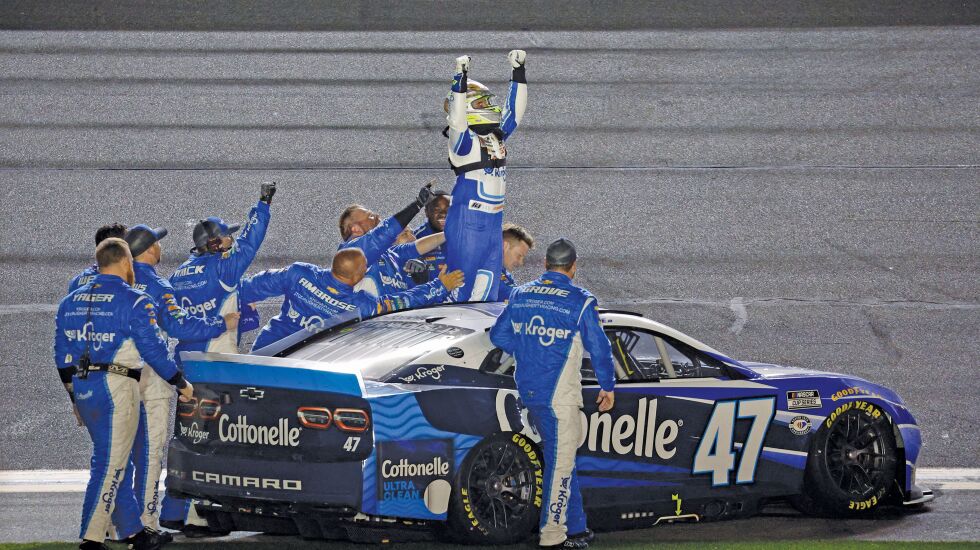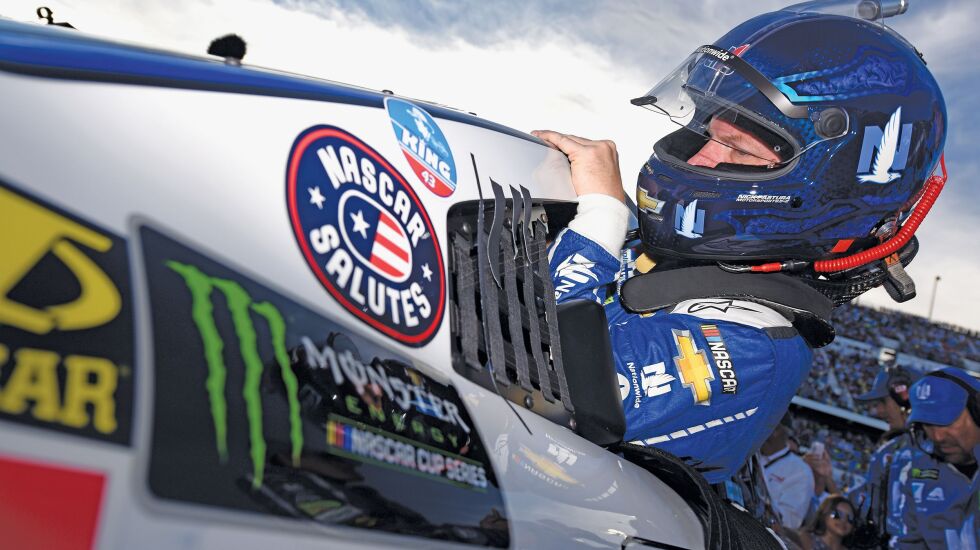
Not long after winning the Daytona 500 in February, Ricky Stenhouse Jr. took a trip up to Chicago, where he’ll be doing a little driving when NASCAR takes over our downtown streets with July 1 and 2 races in its first-ever visit to the city.
Was it just like Stenhouse’s hometown of Olive Branch, Mississippi?
“Oh, yeah, real similar,” he says. “Except for the buildings. And I guess the water.”

Not to mention all the people; it turns out Chicago has millions more of them, some of whom aren’t even diehard fans of stock-car racing. Who knew?
NASCAR’s traveling show is coming to town for an Xfinity Series race on Saturday and the biggie, the Cup Series’ Grant Park 220 on Sunday. Are those cars and drivers ready for us? Are we ready for them?
Harrison Burton traveled here, too, to check out what would become the Chicago Street Race’s 2.2-mile, 12-turn, seven-90-degree-turn course, or track, or highway to hell and back; whatever you want to call it.
“It was wild,” he says. “I was just cruising in traffic. It was still just normal streets, and the [stoplights] were up. To me, that’s crazy. We normally go to places that are year-round set up and kind of permanent, and it’s just so different. It was mind-blowing to think about. Some of the corners there are a little tight even in a street car. It’s going to be a challenge.”

It’s going to be tight and it’s going to get gnarly, the drivers expect, with cars perhaps exceeding 100 mph on relatively short straightaways, having to slow way down — 40 mph or so? — into several turns and “trading paint” like nobody’s business. Picture a few dozen shopping carts flying into a cart corral all at once outside your local Jewel, if it helps. There will be lots of collisions and probably a good bit of chaos, making it tough on the dudes behind the steering wheels but, NASCAR hopes, such a spectacle that folks here will look forward to the races returning around the Fourth of July in 2024 and 2025.
This ain’t NASCAR country, though, certainly not inside the city. You knew that already.
“I had someone in Chicago ask me what NASCAR was,” Burton says. “I was like, ‘Holy cow.’ That’s crazy to me. Obviously, my whole life is NASCAR and it revolves around the sport. For me to hear someone who doesn’t even know what it is, much less what we’re doing and who we are — anything, no idea what our sport even is — is seriously crazy.
“But that’s a good thing. Now we have an opportunity to make a first impression and, hopefully, a good one.”
AT DAYTONA, A LATE CRASH froze the field and helped Stenhouse hold off reigning Cup Series champion Joey Logano to find the checkered flag. Caught up in the wreck behind them were Kyle Busch, Brad Keselowski, Denny Hamlin, Bubba Wallace, Ryan Blaney, A.J. Allmendinger and defending race winner Austin Cindric. And all that happened on a huge track in a race that went to double overtime (wait, there’s such a thing as overtime?) and lasted 212 laps and 530 miles. Sunday’s Chicago race — shorter and slower, for sure, and likely much more of a meat grinder — is set for 100 laps and 220 miles.
How different will Chicago be from an iconic oval like Daytona?
“I would say it’s like golf and hockey, just totally different,” Stenhouse says. “Or it’s like you’re playing for the Chicago Cubs and then you go play for the Blackhawks, right? Like, it’s totally different. You’re on ice, or you’re on grass and dirt. But you’re also using a stick and swinging a bat, so there’s some similarities.”
Are we all following along with this?
“From Daytona to Chicago, man, there is nothing but the car that’s the same,” he simplified.
That’s the crux of the biscuit.
Let’s get to the particulars of the course, which will start and finish on Columbus Drive near Buckingham Fountain. Drivers will head south into Turn 1, which is a 90-degree left onto Balbo Street, before making another 90-degree turn, southward, onto DuSable Lake Shore Drive. From there it’s to Roosevelt Road, west to Columbus, north to Balbo and west to Michigan Avenue. (We may have gotten a little tired of typing “90-degree turn,” but there are a few more of them in there.) Going north on Michigan, drivers will veer into the complicated little arc that is East Congress Plaza drive before continuing onto Michigan and to Jackson Boulevard, for a final 90-degree turn — the seventh — north to Columbus, where Pit Row also happens to reside.

NBC analyst Dale Earnhardt Jr., who will be on the television broadcast, points out a few of the factors that will make racing difficult: the variations in surfaces from street to street, a reality of city driving; a surprisingly sharp bend on Lake Shore between Balbo and Roosevelt; and the quick rise and drop of street level on Balbo coming into Turn 7, which will force drivers to “mash the brakes” as they turn in thick traffic onto Michigan.
“I would expect the unexpected,” Earnhardt says. “We’ve never ran on a street course before, so the drivers are going to be learning on the fly. They’re going to be making a lot of mistakes.”
That might be fun for those watching, either in person or on TV, but the drivers’ feelings span from mixed to apprehensive to worse, which isn’t to say they aren’t also intrigued.
“I think we’re all excited and we’re all really nervous at the same time,” says Logano, a two-time Cup Series champ.
Busch, another two-time Cup Series champ, foresees a scene that’s, well, rowdy, which also happens to be his nickname: “Rowdy.”
“It’s going to be really narrow in some spots, which is a little concerning, just how tight some of these corners are,” he says. “If somebody’s on the inside of anybody, you’re not going to be able to make it through there too wide, I don’t think. And if somebody spins or gets spun? Then it just blocks the track.”
As long as we’re on nicknames, Alex “The Showman” Bowman shoots it straight.
“I feel like we’re all going to crash a lot,” he says. “So it’ll be exciting one way or the other, super technical, no room for error. And I don’t know if you’ve met this group, but we make a lot of errors.
“We crash at road courses that have super-wide corners, let alone corners that are incredibly narrow. It’s just going to be tough. These cars are big, they don’t stop, they don’t turn, they don’t have a lot of grip. They’re kind of, like, the opposite of [the types of cars] you normally see race on a street course. … The stack-ups are going to be massive. And this group likes to use each other up, so I think there’s going to be a lot of that.”
According to Wallace, one of two in the Cup Series field who drive for Michael Jordan’s 23XI team, many drivers are just plain skeptical about how Chicago will go. Again, what’s entertaining to a viewer — especially a novice one — might be a real bear for the competitors. And even if this maiden foray into a non-traditional market is something of a gimmick, there are points and standings in the balance that are as critical as those at all other stops.
“Ask me at the end of the race and I’ll tell you what I think,” Wallace says.

Allmendinger — “Dinger,” as he is known — is a road-course ringer, having come up in motor sports that way. The wide, the narrow, the good, the bad, the ugly, it’s all part of the street deal, he figures. If anything, Allmendinger is more tuned in to skepticism among traditional-minded racing fans and apprehensions among Chicagoans about a downtown disruption that will be considerable.
“Just like in life right now,” he says, “we’ve got fans who don’t want to see it because they’ve never seen it before and they think it’s dumb. I’m sure we’ve got city officials who are probably a little nervous about it. But, at the end of the day, you’ve got to give it a shot. And I think if it’s put on right, it’s going to be an amazing event.”
Logano shakes his head and laughs at what he calls “pointless” worrying because, well, this thing is happening.
“We have a way of making a bigger deal out of things than what they really are,” Logano says, “so I’m sure it’ll go better than we’re all dreading. We’re dreading the worst that could possibly happen, but it’s probably not going to happen like that because it hasn’t before.”
JULIE GIESE PLAYED A KEY ROLE in the $400 million renovation of Daytona International Speedway and managed the $178 million renovation project at Phoenix Raceway. As president of the Chicago Street Race — and a new resident of the city — she has dealt with city officials, curious residents and clueless reporters in a place where stock-car racing had no foothold before this three-year deal, which she hopes will turn into a more permanent part of the NASCAR schedule.
Does Chicago get it?
“Yes and no,” Giese says. “But, honestly, that’s what’s so fun about it because it just reinforces why we’re there. The reason we’re doing what we’re doing is to teach people about NASCAR.”

But NASCAR, too, will have gotten a major taste of what it means to deal with a Chicago that has been inconvenienced over an extensive, month-long schedule of installing track walls and erecting viewing structures; of restricting parking access and closing off key downtown streets altogether; and of trying to prepare and educate the public about traffic and CTA reroutes and other X’s and O’s, so to speak, as the weather gets nicer and city residents are increasingly eager to get where they’re trying to go.
How much of an outcry will there be during race weekend when the Outer Drive is closed from Randolph Street to just south of the Field Museum? That will be the final major closure after all the other streets on NASCAR’s temporary turf have been, for a week or more, blocked off completely or reduced to local access only.
“Any time you do something for the first time,” Giese says, “it’s change and it’s an education process you have to learn. From what I’ve been told, there’s never been a point in time in the city where both Michigan Avenue and DuSable Lake Shore have been closed at the same time. I understand what it means and the impact that it can have. …
“I think it’s just helping everyone understand how to move around the city and knowing what those street closures look like, where those are, when they are. For us, it’s just making sure we’re minimizing those disruptions.”
We haven’t even mentioned the Taste of Chicago being bumped to September. So much for that early-July tradition.
Good luck fighting all that traffic on the Dan Ryan, the Kennedy, the Ike, the Stevenson. Right?
But the racing will go on, and maybe that leaves it to the rest of us to decide if we want to try to enjoy all this or not.
“There’s definitely an opportunity for it to be not as fun for [drivers] but still a spectacle and something that’s good for our sport,” Stenhouse says. “And if it’s good for our sport, us drivers kind of just figure it out.”
King of just figure it out — let’s call that our theme, then. It rather fits this whole experiment.







